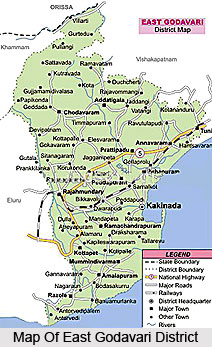 Geography of the East Godavari district, as the name suggests, is closely associated with the Godavari River which occupies a major portion of the delta area. East Godavari District lies between 16o 30" to 18o 20" North Latitude and 81o 30" to 82o 36" East Longitude. It is bounded by Vishakapatnam and Orissa on the North, Bay of Bengal in the South and East and West Godavari district in the West. Khammam lies to the Northwest. The entire east Godavari region can be broadly classified into three natural divisions. These are - the Delta, upland and Agency or hill tracts. The delta portion constituting the whole of Konaseema and portions of Kakinada, Ramachandrapuram and Rajahmundry erstwhile Taluks, presents a vast expanse of rice-fields surrounded by plantain, betel, coconut gardens and innumerable Palmyra`s. The upland areas are constituted by the erstwhile Taluks of Tuni, Pithapuram, Peddapuram and Portions of Kakinada, Ramachandrapuram and Rajahmundry. The general elevation of the East Godavari district varies from a few metres near the sea to about 300 meters in the hills of the agency. The Eastern Ghats mountain range rise by gradations from the level of the coast and spread throughout the erstwhile agency Taluks of Rampachodavaram and Yellavaram.
Geography of the East Godavari district, as the name suggests, is closely associated with the Godavari River which occupies a major portion of the delta area. East Godavari District lies between 16o 30" to 18o 20" North Latitude and 81o 30" to 82o 36" East Longitude. It is bounded by Vishakapatnam and Orissa on the North, Bay of Bengal in the South and East and West Godavari district in the West. Khammam lies to the Northwest. The entire east Godavari region can be broadly classified into three natural divisions. These are - the Delta, upland and Agency or hill tracts. The delta portion constituting the whole of Konaseema and portions of Kakinada, Ramachandrapuram and Rajahmundry erstwhile Taluks, presents a vast expanse of rice-fields surrounded by plantain, betel, coconut gardens and innumerable Palmyra`s. The upland areas are constituted by the erstwhile Taluks of Tuni, Pithapuram, Peddapuram and Portions of Kakinada, Ramachandrapuram and Rajahmundry. The general elevation of the East Godavari district varies from a few metres near the sea to about 300 meters in the hills of the agency. The Eastern Ghats mountain range rise by gradations from the level of the coast and spread throughout the erstwhile agency Taluks of Rampachodavaram and Yellavaram.
Climate in the region of the East Godavari district is relatively moderate throughout the year. The only exceptions are the months of April to June when the temperature reaches a maximum of 48 degrees. The normal rainfall of the region is 1280 mms. The majority of the rainfall, almost more than half of it, is brought by ten South West monsoons while a large portion of the rest of the district receives a rainfall from the North-East monsoon also. This happens during the months of October and November.
The main rivers of the region are the River Godavari, River Pampa, the Thandava and the Yeleru rivers. The soil in the district is mostly alluvial (clay loamy) red soil, sandy loam and sandy clay. There is mostly alluvial soil in Godavari delta and sandy clay soil at the tail end portions of Godavari River, red loamy soil in upland and agency area of the district. East Godavari is one of the agriculturally potential districts in the state of Andhra Pradesh. Situated in the Krishna Godavari Agro Climatic Zone, it contributes about 10% of the total food production of the State. The major crop of the district is paddy which is cultivated in both kharif and rabi as both irrigated and un-irrigated crop. Maize too is grown in both kharif and rabi. However pulses are concerned, black gram and green gram are the major crops. Among oilseeds, the major cultivations include those of Sesamum and kharif in both kharif and rabi. Other crops grown here include sugarcane and jowar.



















